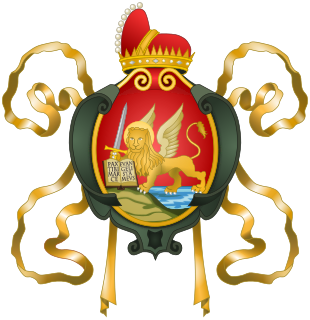
The Doge of Venice, sometimes translated as Duke, was the chief magistrate and leader of the Republic of Venice between 726 and 1797.

The Fourth Crusade (1202–1204) was a Latin Christian armed expedition called by Pope Innocent III. The stated intent of the expedition was to recapture the Muslim-controlled city of Jerusalem, by first defeating the powerful Egyptian Ayyubid Sultanate, the strongest Muslim state of the time. However, a sequence of economic and political events culminated in the Crusader army's 1202 siege of Zara and the 1204 sack of Constantinople, the capital of the Greek Christian-controlled Byzantine Empire, rather than Egypt as originally planned. This led to the partitioning of the Byzantine Empire by the Crusaders.
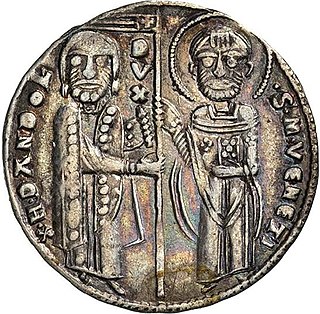
Enrico Dandolo was the Doge of Venice from 1192 until his death. He is remembered for his avowed piety, longevity, and shrewdness, and is known for his role in the Fourth Crusade and the Sack of Constantinople. Dandolo died in 1205 in Constantinople and was buried at the Hagia Sophia.

Pietro Ziani was the 42nd Doge of Venice from 15 August 1205 to 1229, succeeding Enrico Dandolo. He was the son of Doge Sebastian Ziani of the very rich noble family. He was married to Maria Baseggio and Constance of Sicily.
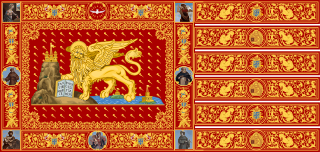
The Republic of Venice or Venetian Republic, traditionally known as La Serenissima, was a sovereign state and maritime republic in parts of present-day Italy which existed for 1100 years from 697 AD until 1797 AD. Centered on the lagoon communities of the prosperous city of Venice, it incorporated numerous overseas possessions in modern Croatia, Slovenia, Montenegro, Greece, Albania and Cyprus. The republic grew into a trading power during the Middle Ages and strengthened this position during the Renaissance. Citizens spoke the still-surviving Venetian language, although publishing in (Florentine) Italian became the norm during the Renaissance.

The siege of Zara or siege of Zadar was the first major action of the Fourth Crusade and the first attack against a Catholic city by Catholic crusaders. The crusaders had an agreement with Venice for transport across the sea, but the price far exceeded what they were able to pay. Venice set the condition that the crusaders help them capture Zadar, a constant battleground between Venice on one side and Croatia and Hungary on the other, whose king, Emeric, pledged himself to join the Crusade. Although some of the crusaders refused to take part in the siege, the attack on Zadar began in November 1202 despite letters from Pope Innocent III forbidding such an action and threatening excommunication. Zadar fell on 24 November and the Venetians and the crusaders sacked the city. After wintering in Zadar, the Fourth Crusade continued its campaign, which led to the siege of Constantinople.

The maritime republics, also called merchant republics, of the Mediterranean Basin were thalassocratic city-states in Italy during the Middle Ages. Since 1947, four of them have the coat of arms inserted in the flag of the Italian Navy: Venice, Genoa, Pisa, and Amalfi; the other republics are: Ragusa, Gaeta, Ancona, and the little Noli.
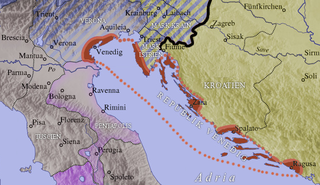
The Republic of Venice was a sovereign state and maritime republic in northeastern Italy, which existed for a millennium between the 8th century and 1797.

The Second Ottoman–Venetian War was fought between the Islamic Ottoman Empire and the Republic of Venice for control of the lands that were contested between the two parties in the Aegean Sea, Ionian Sea, and the Adriatic Sea. The war lasted from 1499 to 1503.
The Venetian–Genoese Wars were a series of struggles between the Republic of Genoa and the Republic of Venice, at times allied with other powers, for dominance in the Mediterranean Sea between 1256 and 1381. There were four bouts of open warfare, in which the fighting between the two republics took place largely at sea. Even during periods of peace, incidents of piracy and other minor outbreaks of violence between the two trading communities were commonplace.

The Byzantine Empire was ruled by emperors of the Angelos dynasty between 1185 and 1204 AD. The Angeloi rose to the throne following the deposition of Andronikos I Komnenos, the last male-line Komnenos to rise to the throne. The Angeloi were female-line descendants of the previous dynasty. While in power, the Angeloi were unable to stop the invasions of the Turks by the Sultanate of Rum, the uprising and resurrection of the Bulgarian Empire, and the loss of the Dalmatian coast and much of the Balkan areas won by Manuel I Komnenos to the Kingdom of Hungary.

The Nicaean–Venetian Treaty of 1219 was a trade and non-aggression defense pact signed between the Empire of Nicaea and the Republic of Venice, in the form of an imperial chrysobull issued by Emperor Theodore I Laskaris. This treaty provided the Venetians freedom of trade and imports without customs duties throughout the Empire, in exchange for not supporting for the newly created Latin Empire.
The Peace of Turin of 1381, ended the War of Chioggia (1376–81), in which Venice, allied with Cyprus and Milan, had narrowly escaped capture by the forces of Genoa, Hungary, Austria, Padua and the Patriarchate of Aquileia. Venice had overcome this crisis, forcing the surrender of the Genoese fleet at Chioggia, fighting a second Genoese fleet to a standstill in the Adriatic, and turning Austria against Padua, thus forcing its most threatening landward opponent into retreat. However, the war had been extremely costly for Venice, and it was only able to secure peace by making major concessions to its opponents.
This article presents a detailed timeline of the history of the Republic of Venice from its legendary foundation to its collapse under the efforts of Napoleon.
The Treaty of Sapienza was concluded in June 1209 between the Republic of Venice and the newly established Principality of Achaea, under Prince Geoffrey I of Villehardouin, concerning the partition of the Peloponnese (Morea) peninsula, conquered following the Fourth Crusade. By its terms, Venice, which had been accorded most of the Peloponnese in the Partitio Romaniae, recognized Villehardouin in possession of the entire peninsula except for the two forts of Modon and Coron, which came under Venetian control, and secured commercial and tax privileges in the Principality. The text of the treaty is also a valuable primary source for the early history of the Principality of Achaea.
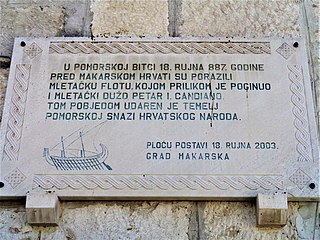
The Croatian–Venetian wars were a series of periodical, punctuated medieval conflicts and naval campaigns waged for control of the northeastern coast of the Adriatic Sea between the City-state of Venice and the Principality of Croatia, at times allied with neighbouring territories – the Principality of the Narentines and Zahumlje in the south and Istrian peninsula in the north. First struggles occurred at the very beginning of the existence of two conflict parties, they intensified in the 9th century, lessened during the 10th century, but intensified again since the beginning of the 11th century.

In 1268, the Byzantine Empire and the Republic of Venice agreed to temporarily end the hostilities which had erupted after the Byzantine recovery of Constantinople by Emperor Michael VIII Palaiologos in 1261.
The Podestà of Constantinople was the official in charge of Venetian possessions in the Latin Empire and the Venetian quarter of Constantinople during the 13th century. Nominally a vassal to the Latin Emperor, the Podestà functioned as a ruler in his own right, and answered to the Doge of Venice. The podestà was also officially known as Governor of One-Fourth and One-Half of the Empire of Romania and was entitled to wearing the crimson buskins as the emperors.

The Duchy of Durazzo was a short-lived overseas colony of the Republic of Venice, encompassing the port city of Durazzo and its environs. It was established in 1205, following the dissolution of the Byzantine Empire in the aftermath of the Fourth Crusade, and lasted until it was reclaimed by the Byzantine Despotate of Epirus in 1213.
The Byzantine–Venetian treaty of 1277 was an agreement between the Byzantine Empire and the Republic of Venice that renegotiated and extended for two years the previous 1268 treaty between the two powers. The agreement was beneficial for both sides: Byzantine emperor Michael VIII Palaiologos kept the Venetians and their fleet from participating in the attempts of Charles of Anjou to organize an anti-Byzantine crusade, while the Venetians were able to retain their access to the Byzantine market, and even augment their trading privileges by gaining direct access to the Black Sea and the right to their own quarters in Constantinople and Thessalonica. Furthermore, they were able to stop the Byzantine reconquest of Venetian-aligned territories in the Aegean, although the treaty explicitly allowed both sides to continue fighting for control of the island of Euboea (Negroponte). Nevertheless, the agreement's short duration made clear that for both parties, it was a temporary expedient. After the treaty expired, the Venetians allied with Charles of Anjou, but their plans were thwarted by the outbreak of the War of the Sicilian Vespers in 1282, forcing Venice once more to renew the peace with the Byzantines in 1285.















